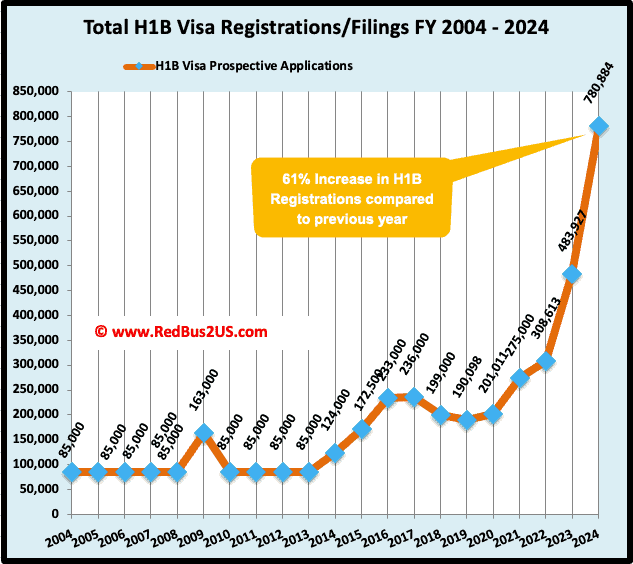Introduction:
The H-1B visa program, established in 1986, allows US employers to temporarily hire foreign workers in specialty occupations requiring the “theoretical and practical application of a body of specialized knowledge.” These occupations often involve fields like engineering, computer science, healthcare, and academia. While the program aims to attract highly skilled professionals to contribute to the US economy, its complexities and potential downsides have sparked ongoing debate. Jobs in fields such as mathematics, engineering, technology, and medical sciences often qualify. The current annual statutory cap for H-1B visas stands at 65,000, with an additional allocation of 20,000 visas reserved for foreign professionals who have earned a master’s degree or doctorate from a U.S. institution of higher learning. However, the number of applicants applying each year has increased to 300,000+ in 2024, with the upper cap remaining unchanged for the past 20 years.
Understanding H-1B Visas
Eligibility and Application Process:
To qualify for an H-1B visa, foreign workers must possess a bachelor’s degree (or its equivalent) in the specialty field or demonstrate equivalent experience. The sponsoring employer must file a Labor Condition Application (LCA) with the Department of Labor (DOL) attesting to:
1. Paying the prevailing wage for the specific occupation in the geographic area.
2. Offering the same working conditions and benefits as those offered to US workers performing similar jobs.
3. Not laying off US workers with similar qualifications within the previous 90 days.
Once the LCA is approved, the employer can petition for the H-1B visa on behalf of the foreign worker through US Citizenship and Immigration Services (USCIS). The petition includes detailed information about the job offer, worker qualifications, and supporting documentation.
Rights and Limitations:
H-1B visa holders are authorized to work for the sponsoring employer for a maximum of three years, with the possibility of a one-time extension for an additional three years. They can change employers through a process called “portability,” requiring the new employer to file a new LCA and petition. However, they remain dependent on the sponsoring employer for their visa status, limiting their job mobility. Additionally, H-1B visa holders have dual intent, meaning they can pursue permanent residency (green card) while on the visa.
Types of H-1B Visas:
Beyond the standard H-1B visa subject to the annual cap, several exempt categories exist:
Institutions of Higher Education:
Universities and colleges play a vital role in nurturing innovation and fostering knowledge exchange. Recognizing this, the H-1B program grants them the unrestricted ability to petition for H-1B visas for foreign professionals. This includes professors from diverse disciplines, researchers conducting groundbreaking studies, and other qualified individuals employed for teaching or research purposes. Universities can significantly expand their pool of talent and expertise without being constrained by the cap, fostering a vibrant academic environment for both domestic and international students.
Non-Profit Entities Affiliated with Institutions of Higher Education:
Non-profit organizations closely associated with universities and colleges, such as research institutes, hospitals, and technology transfer centers, also benefit from cap-exempt status. These entities play a critical role in bridging the gap between academic research and practical applications, potentially leading to groundbreaking discoveries and advancements. While the number of visas they can petition for is limited, they are exempt from the standard lottery, allowing them to access the specific talent needed to fulfill their critical missions.
Non-Profit Research Organizations:
The H-1B program recognizes the immense contributions of non-profit research organizations in advancing scientific understanding and technological breakthroughs. These organizations, often conducting research and development in areas like public health, environmental sustainability, and energy innovation, are exempt from the cap. This allows them to petition for H-1B visas for qualified researchers, regardless of nationality, contributing to advancements that benefit society as a whole.
Government Research Organizations:
Recognizing the importance of government-funded research in areas like national security, defense, and public health, the H-1B program exempts U.S. government agencies and research institutions from the cap. This allows them to petition for foreign researchers with specialized expertise to work on specific research projects funded by the government. This exemption ensures critical research initiatives can access the necessary talent, regardless of geographical origin, contributing to national progress and security.
Common Misconception:
A common misconception is that H-1B visas allow employers to hire foreign workers at lower wages than their US counterparts. However, the LCA requirement ensures that prevailing wages are offered. Additionally, some mistakenly believe that H-1B holders permanently displace US workers. While concerns about potential displacement exist, studies suggest minimal negative impact on US worker wages and employment.

The "Gamble" Aspect
Competitive Lottery System:
The H-1B visa program is subject to an annual cap of 65,000 visas, with an additional 20,000 reserved for individuals with U.S. master’s degrees or higher. However, the number of applications typically far exceeds the available slots, resulting in a competitive lottery system. In FY 2023, USCIS received over 480,000 petitions for the 85,000 available visas, with a selection rate of approximately 17%. This high level of competition creates uncertainty for both employers and employees, making the process a significant gamble.
Risks for Employers:
Aside from the lottery uncertainty, employers face potential legal and financial consequences for non-compliance with LCA requirements. Additionally, they may experience difficulties filling positions due to the complexities and uncertainties of the program. Furthermore, relying heavily on H-1B workers can create dependence and limit employer flexibility, as the visa holders’ employment is tied to the sponsoring employer.
Risks for Employees:
Employees on H-1B visas face significant limitations, including dependence on their employers for maintaining their visa status. This dependence can restrict their job mobility and potentially lead to exploitation or unfair treatment. Additionally, career advancement opportunities might be limited as they remain tied to the specific sponsoring employer for a set period.
Ethical Concerns:
Ethical concerns surround potential misuse of the H-1B system, such as:
Wage suppression: Some argue that companies might use H-1B visas to hire foreign workers at lower wages, potentially undercutting US workers’ wages.
Displacement of US workers: While studies suggest minimal overall impact, concerns persist about potential displacement of US workers in specific industries and job categories.
Balancing Opportunity and Risk
Potential Reforms to Address Challenges:
Several potential reforms have been proposed to address the challenges and mitigate risks associated with the H-1B program:
Increase the H-1B visa cap: Raising the annual cap could alleviate the lottery’s competitive pressure and provide more opportunities for skilled foreign workers.
Implement a skills-based system:
Replacing the lottery with a system that prioritizes workers with the most in-demand skills could improve efficiency and ensure the program attracts the most qualified individuals.
Streamline the application process:
Reducing processing times and simplifying procedures could benefit both employers and employees.
Strengthen enforcement of LCA regulations:
Increased scrutiny and stricter penalties for non-compliance could deter wage suppression and protect US worker rights.
Invest in STEM education and training:
Focusing on domestic talent development in science, technology, engineering, and mathematics (STEM) fields could reduce reliance on foreign workers and equip US workers with skills needed in the modern economy.
Balancing Perspectives:
The H-1B program sparks strong opinions from various stakeholders:
1. Employers: They often advocate for increased access to skilled foreign workers to address talent shortages and maintain a competitive edge in the global marketplace.
2. Employees: They emphasize ensuring the program protects their rights and prevents wage suppression or exploitation.
3. Lawmakers: They navigate the complex balance between attracting skilled individuals, protecting US workers, and fostering economic growth.
4. Immigration experts: They offer insights into the program’s effectiveness and potential improvements.
Finding a solution requires considering diverse perspectives and prioritizing a balanced approach that maximizes the program’s benefits while minimizing downsides.
The Economic Impact
The economic impact of the H-1B visa program is a subject of debate, with proponents citing benefits such as job creation, increased innovation, and filling talent shortages in critical sectors. Studies suggest that H-1B visa holders contribute to economic growth by bringing advanced skills and expertise, leading to innovation and productivity gains. However, concerns about potential drawbacks, such as wage suppression and displacement of US workers, persist. While studies indicate minimal evidence of widespread wage suppression or displacement, these concerns underscore the need for careful oversight and policy reforms to ensure that the H-1B visa program maximizes its benefits while minimizing any adverse effects on the US labor market.
Alternative Pathways for Attracting Talent:
Several alternative pathways exist for attracting and retaining skilled workers in the US:
1. Green card reform: Streamlining the green card process could provide greater certainty and flexibility for skilled individuals seeking permanent residency.
2. Education and training initiatives: Investing in programs that equip US workers with in-demand skills could reduce reliance on foreign workers and address potential skills gaps.
3. Global talent partnerships: Collaboration with international universities and institutions could facilitate knowledge exchange and foster international collaborations.
Conclusion:
The H-1B visa program is a complex and multifaceted issue with significant implications for both employers and employees. Balancing the program’s potential benefits with the inherent risks requires a nuanced approach. Implementing reforms to address the existing challenges, fostering an environment of ethical recruitment and employment practices, and exploring alternative pathways for talent acquisition are crucial steps toward ensuring the program operates in the best interests of the US economy and workforce. Ultimately, finding solutions necessitates ongoing dialogue and collaboration among stakeholders to create a system that promotes innovation and economic growth while safeguarding the rights and opportunities of both US workers and skilled foreign professionals.
Disclaimer:This article is for informational purposes only and does not constitute legal advice. Readers are encouraged to consult with qualified immigration attorneys for specific guidance on their individual situations.
Written by – Saakshi Dedhia
Edited by – Kushi Mayur




